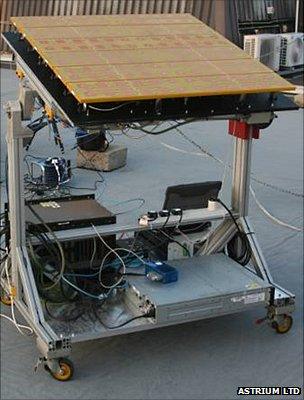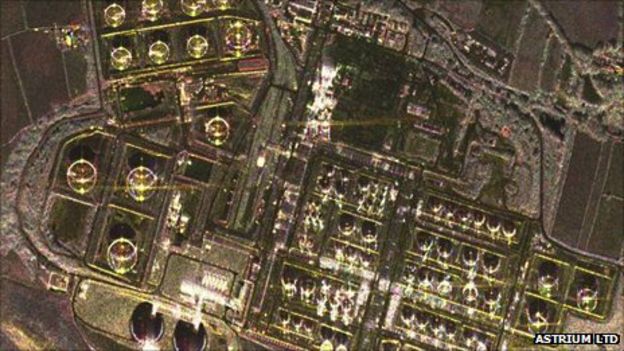The British spacecraft manufacturer SSTL has announced its intention to start building radar satellites.
It is a significant move for the Guildford-based company which has, until now, been associated with small, low-cost satellites that view the Earth at optical and near-infrared wavelengths, producing images that are recognisably the sort of thing we see with our own eyes.
NovaSar-S (Sar stands for synthetic aperture radar) will be a 3m-by-1m spacecraft with an interesting shape and weighing just shy of 400kg.
SSTL is presenting details of the new platform at this week’s International Astronautical Congress in South Africa.
Radar is a very different technology to what it has offered previously and makes for a very different type of picture, one that can look quite strange to the untrained eye.
It requires the satellite to fire multiple microwave pulses at the ground and then build up pictures from the echoes.
The principal advantage over optical Earth observation is that radar is all-weather. Whereas an optical camera positioned in space and pointed at the ground cannot see through cloud, a radar imager can – and you get just the same picture whether it is day or night.
 Image copyrightOTHER
Image copyrightOTHERSSTL’s decision is fascinating because radar satellites have traditionally been big, power-hungry beasts. It takes a lot of energy to generate the pulses and then to process the echo returns. The problem for SSTL has been in devising a package that is relatively small and inexpensive – the company’s trademarks.
SSTL hopes to be able to build, insure and launch a NovaSar-S for less than 50 million euros, not the more-than-one-hundred million euros you could spend on a radar satellite.
Luis Gomes is the head of Earth observation at SSTL.
“The cost associated with generating the power pulses has always been a big issue, and managing that power,” he told me.
“We’ve addressed this by using new technology – new types of amplifier from commercial terrestrial applications in telecommunications.
“Another issue that has prevented us from doing Sar previously was the technology in terms of data processing. Sar generates a lot of data – 20-30 times more data per second compared to our original optical data processing systems.
“But because optical systems have become more complex as we’ve gone to higher resolutions, we now have the systems that can cope with Sar.”
The NovaSar-S project has been in gestation for a number of years, and has involved research at SSTL, the Space Centre at Surrey University; and at SSTL’s parent company, Astrium. Indeed, the 3m x 1m phased array antenna which gives the satellite its distinctive, plank-like appearance was developed by the Sar specialists at Astrium, Europe’s biggest space company.
 Image copyrightOTHER
Image copyrightOTHERA testbed has been flown on an aircraft, and you can see a resulting image on this page.
NovaSar-S will produce what are termed medium resolution pictures, where details on the ground larger than 6m across would be discernable.
The satellite will have a number of viewing modes that will enable it to perform a wide range of roles, from flood monitoring and land cover classification to disaster mapping and maritime enforcement – notably ship tracking and oil spill detection.
An application where the satellite could find a particularly useful role is in monitoring forests – or to be more precise: in monitoring deforestation. The cloud cover associated with rainforests makes Sar something of a game-changer in that sense, allowing repeat viewing of an area on a frequent basis whatever the weather. SSTL says three NovaSar-S satellites flown in a constellation of three could image any point on the globe every day.
The new amplifier technology will soon be trialled on TechDemoSat-1, a British spacecraft designed to showcase novel UK space technologies. It’s possible that TechDemoSat-2, if and when this platform is approved by government, could become a demonstrator dedicated to the new SSTL Sar system. The rationale behind the TDS programme is that foreign governments and companies are more likely to purchase innovative UK tech if they see it flying first.
“We’d like to have a full-blown demonstrator for the Sar, and particularly with the objective of demonstrating services,” explained Mr Gomes.
“It’s nice to have the technology but we want people to engage in terms of services – to come up with uses for this sort of data for the scientific community and commercial world. These discussions are on-going.”
Source: http://www.bbc.com/news/science-environment-15156400
